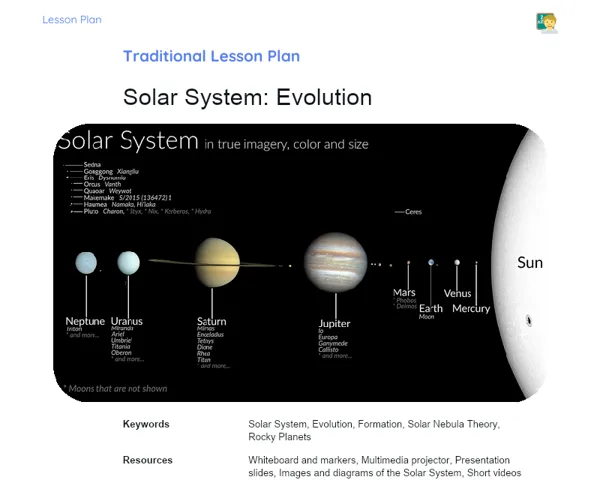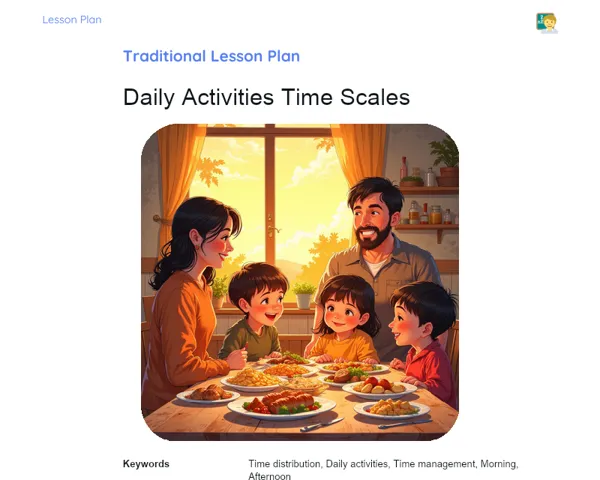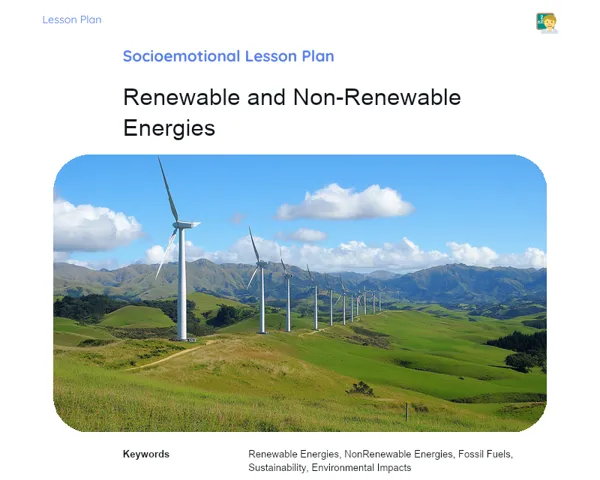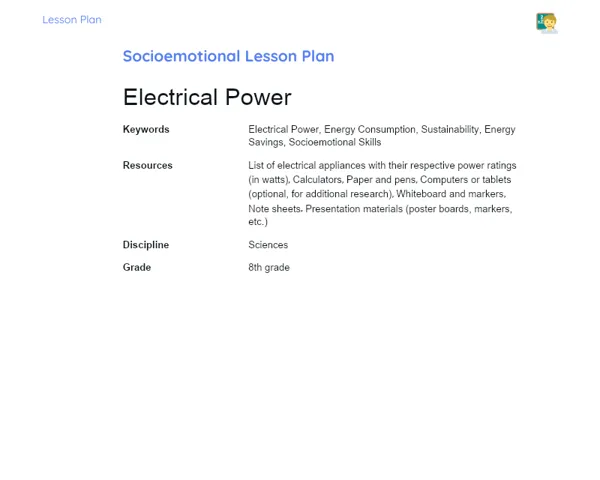Lesson Plan | Lesson Plan Iteratif Teachy | Chemical Bonds: Ionic and Covalent
| Keywords | Chemical Bonds, Ionic Bonds, Covalent Bonds, Chemical Compounds, NaCl, H2O, Digital Methodology, Social Media, Practical Activities, Educational Technology, Collaborative Learning, Interactive Quizzes, WebQuest, Online Research |
| Resources | Cell phones with internet access, Computers or tablets, Access to social media platforms (Instagram, TikTok, etc.), Quiz creation platforms (Kahoot, Quizizz, etc.), Platforms for creating websites/blogs (Google Sites, Wix, Blogger, etc.), Projector or screen for presentations, Materials for note-taking (notebooks, pens, etc.) |
| Codes | - |
| Grade | 9th grade |
| Discipline | Sciences |
Goal
Duration: 10 - 15 minutes
The aim of this stage is for learners to grasp the learning objectives clearly, helping them understand what's expected by the end of the lesson. This sets them up to engage more effectively in practical tasks and to link their prior knowledge with the content they'll explore online.
Goal Utama:
1. Understand what covalent and ionic bonds are, while identifying their features and differences.
2. Identify ionic and covalent compounds, using NaCl as an example of an ionic compound and H2O as a covalent compound.
Goal Sekunder:
- Encourage teamwork in digital activities.
- Promote the use of tech tools for researching and presenting chemical principles.
Introduction
Duration: 10 - 15 minutes
This stage aims to hook learners right away by using technology they're comfortable with, sparking their curiosity about the topic. This helps foster a collaborative and engaging environment, gearing them up for the next part of the lesson where they will delve deeper into the concepts of chemical bonds.
Warming Up
Let the learners know that chemical bonds are crucial for the creation of all materials we encounter. Ionic and covalent bonds are major ways atoms combine to form compounds. Ask learners to find an interesting fact about ionic or covalent bonds using their phones and share it with the class.
Initial Thoughts
1. What are the key features of ionic and covalent bonds?
2. Can you give examples of compounds with ionic bonds and those with covalent bonds?
3. Why are chemical bonds vital in forming substances?
4. How does each type of bond influence the properties of the compounds formed?
Development
Duration: 70 - 80 minutes
This stage allows learners to apply and solidify their knowledge about ionic and covalent bonds through practical and engaging activities using tools that are a part of their everyday lives. The planned activities promote collaboration, creativity, and efficient use of technology for educational purposes.
Activity Suggestions
Activity Recommendations
Activity 1 - 🤖 Chemistry Mission on Social Media
> Duration: 60 - 70 minutes
- Goal: Harness modern digital skills to enhance understanding and communication around the topic of chemical bonds creatively.
- Deskripsi Activity: Students will transform into digital influencers, creating informative posts on their social media (Instagram, TikTok, etc.) about the contrasts between ionic and covalent bonds, using videos, images, and interactive stories to captivate their audience.
- Instructions:
-
Split the class into groups of up to 5 learners.
-
Each group must pick a social media platform (Instagram, TikTok, etc.) for their content.
-
Groups will employ their phones to gather additional information and craft multimedia content (videos, images, stories) that explains the differences between ionic and covalent bonds.
-
Suggestions for learners: include examples like NaCl for ionic bonds and H2O for covalent, using animations or role-plays if possible.
-
Teams should post their content on a social media account created specifically for the task (these can be imaginary or real accounts, depending on school policy).
-
Each group will present their content to the class, elaborating on the choices made in their material.
Activity 2 - 🎮 Chemical Bonds: The Interactive Game
> Duration: 60 - 70 minutes
- Goal: Encourage cooperative and competitive learning, fostering the review and consolidation of the concepts of chemical bonds playfully.
- Deskripsi Activity: Create an interactive game using a digital platform (like Kahoot or Quizizz) where learners design quizzes about ionic and covalent bonds. The aim is for students to challenge themselves and learn in a fun, competitive atmosphere.
- Instructions:
-
Divide the class into groups of up to 5 learners.
-
Each group should access an online quiz platform (Kahoot, Quizizz, etc.) and craft an interactive quiz about ionic and covalent bonds.
-
The quiz should cover questions on the features and examples of each bond type.
-
Students can use multimedia resources like images and videos to enhance questions and answers.
-
After all groups have developed their quizzes, everyone plays the quizzes made by the other groups.
-
Groups should reflect on the questions they got wrong and discuss the correct answers.
Activity 3 - 📚 Chemistry Investigation: WebQuest
> Duration: 60 - 70 minutes
- Goal: Enhance research and digital communication skills, while deepening their understanding of chemical bonds through investigation and teamwork.
- Deskripsi Activity: Learners will engage in a WebQuest, an online research activity where they must gather information about ionic and covalent bonds, presenting it at the end in the format of a website or blog.
- Instructions:
-
Split the class into groups of up to 5 learners.
-
Each group gets a list of questions and topics to cover on ionic and covalent bonds.
-
Using their phones and/or computers, groups will research and answer the posed questions.
-
They should organise the gathered information into a website or blog, using platforms like Google Sites, Wix, or Blogger.
-
The websites/blogs should have clear sections on what ionic and covalent bonds are, their main features, examples of compounds, and their significance.
-
Each group will then present their website/blog to the class, explaining how they organised the information and the digital tools they used.
Feedback
Duration: 15 - 20 minutes
This stage allows students to reflect on what they have learned while sharing their thoughts with others and receiving supportive feedback. It aids in consolidating knowledge through exchanging experiences and fosters interpersonal and self-assessment skills.
Group Discussion
Lead a discussion with all students, where groups share what they learned from the activities and their reflections. Use the following prompts to shape the conversation: 'Let's chat about what we discovered about chemical bonds. Each group will get a chance to share their insights and conclusions. Start by briefly narrating how it was making the digital content or quiz. What surprised you most during your research and the activities?'
Reflections
1. What were the key insights about ionic and covalent bonds that you gained from these activities? 2. How did using social media or digital platforms help clarify the concepts of chemical bonds for you? 3. What do you think could be improved to make the explanations of ionic and covalent bonds clearer and more engaging?
Feedback 360º
Guide learners in a 360° feedback session, where each person will receive thoughts from their group members. Ensure that the feedback is constructive and kind. Say: 'We're going to do a 360° feedback. Each individual will mention something they thought their peer did exceptionally well and something that could be enhanced. Kindly remember to be respectful and constructive, focusing on how everyone can improve.'
Conclusion
Duration: 10 - 15 minutes
This stage aims to consolidate learning and connect the concepts explored during the lesson to the real world and their practical uses. This moment of reflection is vital for learners to realise the relevance of the content and feel inspired to apply what they have learnt in everyday life, reinforcing the transformation of knowledge into practical action.
Summary
🎉 Well done, Digital Chemists! 🎉 Today, you delved into the exciting realm of chemical bonds! 🌌 We learned that ionic bonds involve electron transfer, creating positive and negative ions, like in NaCl 🤖, while covalent bonds happen through the sharing of electrons, as seen in H2O 💧. Through engaging activities on social media, interactive games, and research, you’ve become true chemistry influencers! 👩🔬👨🔬
World
🔗 Chemical bonds are the backbone that literally holds our world together! Grasping these bonds helps us understand everything from the materials of our smartphones 📱 to the chemical reactions occurring in our meals 🍲. The skill to express these concepts creatively and digitally is essential in a time when science and technology are increasingly connected.
Applications
🧪 Chemical bonds impact our daily lives directly. From the butter on our toast 🥖 to the batteries in our devices 🔋, everything revolves around these atomic interactions. Understanding them not only provides a strong foundation in science but also unlocks opportunities for tech innovations and effective solutions to real-world challenges. 🚀



